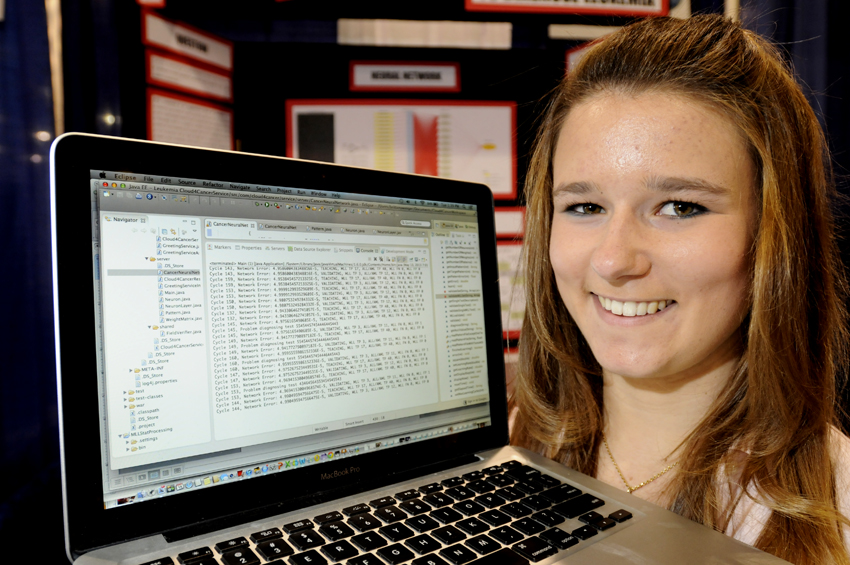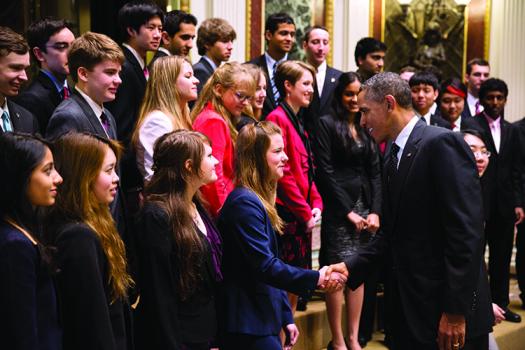The kid who never outgrew ‘but why?’

Brittany Wenger combined medical research and computer science to create a cloud-based service that helps doctors diagnose breast cancer.
Her Cloud4Cancer based service uses attributes from Fine Needle Aspirates to determine if a breast mass is malignant or benign. Through a series of 7.6 million trials, Brittany’s program diagnosed more than 99 percent of cancer patients correctly.
Brittany, a finalist in Intel ISEF 2010-2013 and the 2013 Intel STS, is passionate about using science and data to positively impact human health. Her passions lie at the intersection of big data and medicine.
Read the interview below to find out more about Cloud4Cancer and Brittany’s inspiration.
I was that kid who never outgrew the ‘but why?’ phase so I got involved in science because it was the only way to answer all my questions.
HOW DID YOU FIRST BECOME INTERESTED IN SCIENCE: I was that kid who never outgrew the “but why?” phase. So I got involved in science because it was the only way to answer all of my questions.
The reason I love science is because it gives us the opportunity to answer our own questions. The more you know, the more you wonder. It’s an infinite process and the discovery phase is a great way to blend curiosity, creativity, and analytics.
Inspire other young scientists like Brittany by joining the Society!
My passions lie at the intersection of big data and medicine, creating algorithms to try to improve human health. I’m passionate about using science and data to positively impact human health.
TELL US ABOUT YOUR VISIT TO THE WHITE HOUSE: I’d just turned 18 and voted for the first time when I attended the White House Science Fair in 2013. As an Obama supporter, I was honored by the President’s genuine interaction with my research.
Getting the chance to meet President Obama was surreal in itself. When he stopped by my project and asked specific questions that showed he clearly knew about my research, I was overwhelmed. As he was walking away, he patted my shoulder and said something related to being proud of me.
Since STEM is highly collaborative in nature, having as many perspectives as possible working towards advances is bound to increase discovery.
I’d followed the debates closely, and was a huge supporter of President Obama and his policies. I think having the opportunity to interact and receive further validation from such an important and personable person has been the most memorable part of my White House visit.
Meeting peers at the science fair was valuable. We often support each other in our current scientific endeavors and life situations in general. One of the most valuable parts of the White House Science Fair was that it expanded my network of peer scientists.

WHAT ARE YOUR CURRENT STEM GOALS: I’m currently a junior biology major at Duke University. After graduation, I’ll attend the Icahn School of Medicine at Mount Sinai as part of their FlexMed program, where I was accepted in my sophomore year of college.
I’m heavily involved in science research. I’m the co-president of Duke’s Undergraduate Research Society and work in the Duke Center for Applied Genomics and Precision Medicine. There, I focus on identifying differential exon usage as an agent of immune response in H3N2 influenza and bacterial pneumonia samples. I’m using identified biomarkers to build predictive classifiers.
Differential exon usage is a particularly exciting realm of immune system exploration because the ability to identify differential exon usage has been greatly enhanced by recent technological advances.
While at Duke, I also started a foundation to further the reach of Cloud4Cancer. I also expanded my neural network service to identify aggressive leukemia cases based on genetic expression profiling, and have improved the breast cancer algorithm.
ON THE IMPORTANCE OF MINORITIES IN STEM: We can make more technological breakthroughs when we encourage girls and other students underrepresented in STEM to get involved.
Everyone thinks differently, and since STEM is highly collaborative in nature, having as many perspectives as possible working towards advances is bound to increase discovery. The collaborative nature of science will benefit from as many perspectives as possible.
As a woman in computer science (now bioinformatics) research, I’ve seen first-hand how male-dominated the field can be. Computer science is a tool that can be applied to any discipline to improve our world. We need as much participation in science as possible because it’s the way we unravel the mysteries of our world.
I’m not some whiz kid that was born with a beaker in my hand. I found support from people who helped me advance my research.
ON FINDING SUPPORT IN SCIENCE: Cloud4Cancer was started from my bedroom floor using public domain data. I’m not some whiz kid that was born with a beaker in my hand.
But I was able to find support from my teachers, friends, family, and organizations that helped me advance my research. I hope other kids realize that all it takes to get started in science is a question and passion.
In high school, I had two teachers who were strong role models. My biology teacher Mr. Newhams would stay late to answer questions related to my research. My computer science teacher Mrs. Barrett provided a great example of a woman using computer science to create exciting programs.
That support was key. I think having a supportive environment is important for budding scientists.


